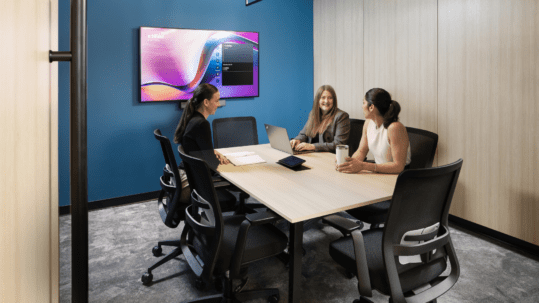Comparing today’s workplace to that of twenty years ago, the office looks vastly different. Workplace design constantly evolves to meet the workforce’s expectations, from standardized cubicles in the 1980s to ping-pong tables and open floorplans in 2010. The latest shift in office design is a trend toward more flexible office environments that support hybrid working models. While the concept of hybrid working is not new and was already in use in some companies before the pandemic, it is quickly becoming the “Next Normal.” Furthermore, according to a recent Forbes survey, 75% of workers believe hybrid work will be standard in their workplaces within three years.
If hybrid work is here to stay, what does a hybrid office look like, how does it differ from a traditional office, and how can businesses reconfigure their space to accommodate this new working model?
What is a hybrid Office? What makes it different from a traditional office?
A hybrid workplace is a flexible model designed to support a distributed workforce of both in-office and remote workers. In a hybrid office, employees have more flexibility. They can choose how they work best and create a balanced work schedule that combines the advantages of working from home and in a traditional office building.
The primary distinction between a hybrid and a traditional office-first workplace is that a hybrid environment is primarily a cultural space. The function of the office has shifted from being the primary place of work to providing workers with a social anchor, enabling learning, and encouraging unscripted, innovative collaboration and connections. Moreover, the office’s purpose shifted from being about work to people, allowing employees flexibility and choices on when, how, and where they work.
Steps to setting up a hybrid office
1. Figure out if a hybrid office is right for you and get leadership alignment
Regarding hybrid working, some industries are better suited than others. Law firms, in particular, struggle to adapt their job roles to a hybrid working environment. Consult with employees and top management to determine whether a hybrid working style is beneficial.
2. Lay out a hybrid office policy (define your work modality)
Because hybrid working can mean different things to different people, companies must determine their default practices to ensure companywide alignment. There are numerous hybrid and remote work models available; therefore, it is vital for everyone to understand what is being proposed. When developing your hybrid office policy, it is critical to define the policy, who it applies to, and the expectations for how employees will work.
3. Invest in the right tools and technology
Investing in the right tools and technology that help support your employees is essential. Special hardware and software investment is needed so a hybrid office can run smoothly. Looking into different software licenses and communication tools are great ways to cultivate a forward-thinking hybrid office.
4. Reconfigure your workplace to maximize hybrid work
A hybrid office is unique, and there are multiple ways to personalize and reconfigure your current office to provide a more flexible working environment.
Here are some design trends for hybrid offices:
- Bringing a sense of “home” to the office
A hybrid office combines the favourable circumstances of working from home and in the office. Integrating Informal areas with lounge furniture where employees can take a break, eat a snack, and socialize with their colleagues is one way to bring a sense of home to the office. Hybrid offices strive to create a balanced environment where employees feel comfortable and well-equipped to produce their best work.
- Shifting Office layouts
Hybrid office design entails reconfiguring existing space and furniture to create more collaborative and flexible workspaces. The fundamental concept of hybrid design is to provide more space for social areas. The office is not only for work but also for connecting employees with one another and the company’s mission and goals. Moreover, hybrid offices are not always smaller than traditional offices; instead, the workplace layout has shifted to prioritize experience-based working (EBW). EBW is based on experience rather than task, with work occurring wherever it is most productive rather than just at a desk. Furthermore, hybrid office layouts favour more flexible collaboration areas where people can easily plug in their own devices and get to work right away.
- Rendering by Steelcase
- Rendering by Steelcase
- Optimized meeting rooms
In a hybrid meeting, one part of the audience joins from the office while another joins remotely. As a result, meeting room designs consider all parties involved in the meeting, not just those in the office. Furthermore, to facilitate hybrid meetings, conference rooms use online content-sharing solutions in conjunction with enhanced audio and video conference technology to improve collaboration among all participants. Virtual attendees are no longer left out; with a fully featured meeting room, in-person and remote participants can collaborate on an equal playing field.
- Bookable workstations
Bookable workstations enabled by desk booking applications are commonplace in a hybrid office where employees only visit the physical office a few times a week. Employees save time by not having to spend extra time looking for a place to work and getting set up or tracking down colleagues who may not even be in the office that day.
- Variety of different working environments
The flexibility of choosing where you work is a significant benefit of hybrid working. Hybrid offices typically have a mix of working environments, including collaborative, private, quiet/focused, and lounge areas. Furthermore, there is even more flexibility in how people work when different workstations are available.
- Third Spaces
In a hybrid office, work and leisure become increasingly blurred. Improved amenities and social facilities, such as cafes, bars, and fitness centers, are essential for attracting employees, strengthening a sense of belonging and shared culture, and encouraging cross-functional connections and non-formal encounters.








